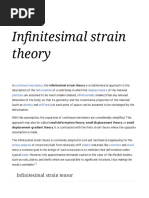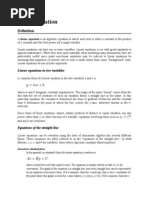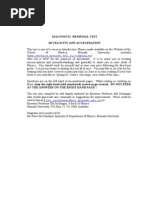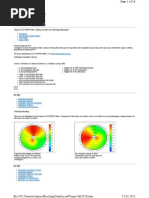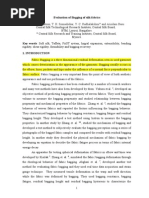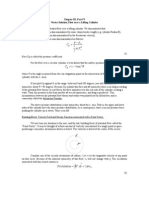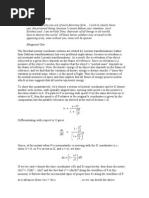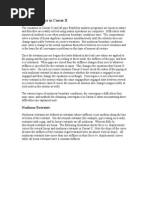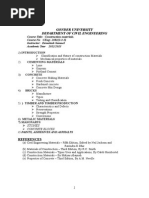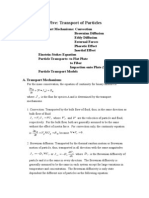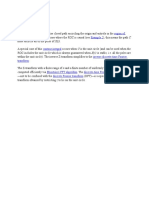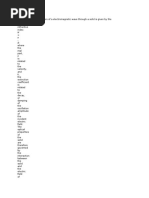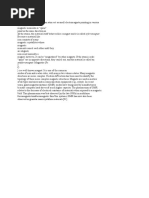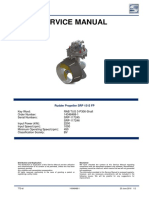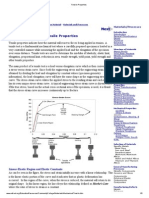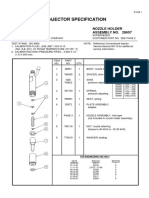Geometric Derivation of The Infinitesimal Strain Tensor
Geometric Derivation of The Infinitesimal Strain Tensor
Uploaded by
alokesh1982Copyright:
Available Formats
Geometric Derivation of The Infinitesimal Strain Tensor
Geometric Derivation of The Infinitesimal Strain Tensor
Uploaded by
alokesh1982Original Description:
Original Title
Copyright
Available Formats
Share this document
Did you find this document useful?
Is this content inappropriate?
Copyright:
Available Formats
Geometric Derivation of The Infinitesimal Strain Tensor
Geometric Derivation of The Infinitesimal Strain Tensor
Uploaded by
alokesh1982Copyright:
Available Formats
Infinitesimal strain theory - Wikipedia, the free
encyclopedia
ry
1 of 18 25-Sep-14 1:53 P
Geometric derivation of the infinitesimal strain tensor
!onsider a t"o-dimensional deformation of an infinitesimal rectan#$lar material
element "ith dimensions %y &'i#$re 1(, "hich after deformation, takes
the form of a rhom%$s) 'rom the #eometry of 'i#$re 1 "e ha*e
'or *ery small displacement #radients, i)e), , "e ha*e
+he normal strain in the -direction of the rectan#$lar element is defined
%y
and kno"in# that , "e ha*e
'i#$re 1) +"o-dimensional #eometric deformation of an
infinitesimal material element)
Similarly, the normal strain in the
-direction, and -direction, %ecomes
+he en#ineerin# shear strain, or the chan#e in an#le %et"een t"o ori#inally ortho#onal material lines, in this case line and , is defined as
'rom the #eometry of 'i#$re 1 "e ha*e
'or small rotations, i)e) and are "e ha*e
and, a#ain, for small displacement #radients, "e ha*e
th$s
,y interchan#in# and and and , it can %e sho"n that
Similarly, for the - and - planes, "e ha*e
It can %e seen that the tensorial shear strain components of the infinitesimal strain tensor can then %e e-pressed $sin# the en#ineerin# strain definition,
, as
Physical interpretation of the infinitesimal strain tensor
'rom finite strain theory "e ha*e
'or infinitesimal strains then "e ha*e
.i*idin# %y "e ha*e
'or small deformations "e ass$me that , th$s the second term of the left hand side %ecomes:
) +hen "e ha*e
"here , is the $nit *ector in the direction of , and the left-hand-side e-pression is the normal strain in the direction of ) 'or
the partic$lar case of in the direction, i)e) , "e ha*e
Similarly, for and "e can find the normal strains and , respecti*ely) +herefore, the dia#onal elements of the
infinitesimal strain tensor are the normal strains in the coordinate directions)
Strain transformation rules
If "e choose an orthonormal coordinate system & ( "e can "rite the tensor in terms of components "ith respect to those %ase *ectors as
In matri- form,
We can easily choose to $se another orthonormal coordinate system & ( instead) In that case the components of the tensor are different, say
+he components of the strain in the t"o coordinate systems are related %y
"here the /instein s$mmation con*ention for repeated indices has %een $sed and ) In matri- form
or
Strain invariants
!ertain operations on the strain tensor #i*e the same res$lt "itho$t re#ard to "hich orthonormal coordinate system is $sed to represent
the components of strain) +he res$lts of these operations are called strain invariants) +he most commonly $sed strain in*ariants are
In terms of components
Principal strains
It can %e sho"n that it is possi%le to find a coordinate system & ( in "hich the components of the strain tensor are
+he components of the strain tensor in the & ( coordinate system are called the principal strains and the directions are called the
directions of principal strain) Since there are no shear strain components in this coordinate system, the principal strains represent the ma-im$m
and minim$m stretches of an elemental *ol$me)
If "e are #i*en the components of the strain tensor in an ar%itrary orthonormal coordinate system, "e can find the principal strains $sin# an
ei#en*al$e decomposition determined %y sol*in# the system of e0$ations
+his system of e0$ations is e0$i*alent to findin# the *ector alon# "hich the stress tensor %ecomes a p$re stretch "ith no shear component)
Volumetric strain
+he dilatation &the relati*e *ariation of the *ol$me( is the trace of the tensor:
1ct$ally, if "e consider a c$%e "ith an ed#e len#th a, it is a 0$asi-c$%e after the deformation &the *ariations of the an#les do not chan#e the *ol$me(
"ith the dimensions and V
2
3 a
3
, th$s
as "e consider small deformations,
therefore the form$la)
4eal *ariation of *ol$me &top( and the appro-imated one &%ottom(: the #reen dra"in# sho"s the estimated *ol$me and the oran#e dra"in# the ne#lected *ol$me
In case of p$re shear, "e can see that there is no chan#e of the *ol$me)
Strain deviator tensor
+he infinitesimal strain tensor , similarly to the !a$chy stress tensor, can %e e-pressed as the s$m of t"o other tensors:
1) a mean strain tensor or volumetric strain tensor or spherical strain tensor, , related to dilation or *ol$me chan#e5 and
2) a de*iatoric component called the strain deviator tensor, , related to distortion)
"here is the mean strain #i*en %y
+he de*iatoric strain tensor can %e o%tained %y s$%tractin# the mean strain tensor from the infinitesimal strain tensor:
Octahedral strains
6et & ( %e the directions of the three principal strains) 1n octahedral plane is "hose normal makes e0$al an#les "ith the three
principal directions) +he en#ineerin# shear strain on an octahedral plane is called the octahedral shear strain and is #i*en %y
"here are the principal strains)
+he normal strain on an octahedral plane is #i*en %y
Equivalent strain
1 scalar 0$antity called the equivalent strain, or the *on ises e0$i*alent strain, is often $sed to descri%e the state of strain in solids)
Se*eral definitions of e0$i*alent strain can %e fo$nd in the literat$re) 1 definition that is commonly $sed in the literat$re on plasticity is
+his 0$antity is "ork con7$#ate to the e0$i*alent stress defined as
Compatibility equations
'or prescri%ed strain components the strain tensor e0$ation represents a system of si- differential e0$ations for the
determination of three displacements components , #i*in# an o*er-determined system) +h$s, a sol$tion does not #enerally e-ist for an ar%itrary
choice of strain components) +herefore, some restrictions, named compatibility equations, are imposed $pon the strain components) With the
addition of the three compati%ility e0$ations the n$m%er of independent e0$ations is red$ced to three, matchin# the n$m%er of $nkno"n
displacement components) +hese constraints on the strain tensor "ere disco*ered %y Saint-8enant, and are called the 9Saint 8enant compati%ility
e0$ations9)
+he compati%ility f$nctions ser*e to ass$re a sin#le-*al$ed contin$o$s displacement f$nction ) If the elastic medi$m is *is$alised as a set of
infinitesimal c$%es in the $nstrained state, after the medi$m is strained, an ar%itrary strain tensor may not yield a sit$ation in "hich the distorted
c$%es still fit to#ether "itho$t o*erlappin#)
In inde- notation, the compati%ility e0$ations are e-pressed as
Engineering notation
Special cases
Plane strain
In real en#ineerin# components, stress &and strain( are 3-.
tensors %$t in prismatic str$ct$res s$ch as a lon# metal %illet, the
len#th of the str$ct$re is m$ch #reater than the other t"o
dimensions) +he strains associated "ith len#th, i)e), the normal
strain and the shear strains and &if the len#th is the 3-
direction( are constrained %y near%y material and are small
compared to the cross-sectional strains) Plane strain is then an
accepta%le appro-imation) +he strain tensor for plane strain is
"ritten as:
in "hich the do$%le $nderline indicates a second order tensor)
+his strain state is called plane strain) +he correspondin# stress
tensor is:
Plane strain state in a contin$$m)
in "hich the non-:ero is needed to maintain the constraint
) +his stress term can %e temporarily remo*ed from the analysis to lea*e
only the in-plane terms, effecti*ely red$cin# the 3-. pro%lem to a m$ch simpler 2-. pro%lem)
Antiplane strain
1ntiplane strain is another special state of strain that can occ$r in a %ody, for instance in a re#ion close to a scre" dislocation) +he strain tensor
for antiplane strain is #i*en %y
Infinitesimal rotation tensor
+he infinitesimal strain tensor is defined as
+herefore the displacement #radient can %e e-pressed as
"here
+he 0$antity is the infinitesimal rotation tensor) +his tensor is ske" symmetric) 'or infinitesimal deformations the scalar components of
satisfy the condition ) ;ote that the displacement #radient is small only if both the strain tensor and the rotation tensor are infinitesimal)
he a!ial vector
1 ske" symmetric second-order tensor has three independent scalar components) +hese three components are $sed to define an a!ial vector, ,
as follo"s
"here is the perm$tation sym%ol) In matri- form
+he a-ial *ector is also called the infinitesimal rotation vector) +he rotation *ector is related to the displacement #radient %y the relation
In inde- notation
If and then the material $nder#oes an appro-imate ri#id %ody rotation of ma#nit$de aro$nd the *ector )
"elation bet#een the strain tensor and the rotation vector
<i*en a contin$o$s, sin#le-*al$ed displacement field and the correspondin# infinitesimal strain tensor , "e ha*e &see +ensor deri*ati*e
&contin$$m mechanics((
Since a chan#e in the order of differentiation does not chan#e the res$lt, ) +herefore
1lso
=ence
"elation bet#een rotation tensor and rotation vector
'rom an important identity re#ardin# the c$rl of a tensor "e kno" that for a contin$o$s, sin#le-*al$ed displacement field ,
Since "e ha*e
Strain tensor in cylindrical coordinates
In cylindrical polar coordinates & (, the displacement *ector can %e "ritten as
+he components of the strain tensor in a cylindrical coordinate system are #i*en %y
>1?
Strain tensor in spherical coordinates
In spherical coordinates & (, the displacement *ector can %e "ritten as
+he components of the strain tensor in a spherical coordinate system are #i*en %y
>1?
You might also like
- Air Conditioner NissanDocument34 pagesAir Conditioner NissanFrederikusNo ratings yet
- Storage and Flow of Solids - Jenike A.W PDFDocument322 pagesStorage and Flow of Solids - Jenike A.W PDFGeorge Markas100% (1)
- Introduction LetterDocument7 pagesIntroduction LetterRavi Sharma100% (1)
- Infinitesimal Strain TensorDocument16 pagesInfinitesimal Strain Tensoralokesh1982No ratings yet
- Infinitesimal Strain TheoryDocument16 pagesInfinitesimal Strain Theoryalokesh1982No ratings yet
- Lab. 3 Rotational Motion: Most Fundamental Concepts Are Substracted From The Web SiteDocument20 pagesLab. 3 Rotational Motion: Most Fundamental Concepts Are Substracted From The Web SiteTesfaye BelayeNo ratings yet
- Geometrical Anatomy and Anatomical MovementsDocument27 pagesGeometrical Anatomy and Anatomical Movementsdenmwa2030ceNo ratings yet
- Infinitesimal Strain Theory - WikipediaDocument18 pagesInfinitesimal Strain Theory - Wikipediaismail adeizaNo ratings yet
- Linear EquationDocument12 pagesLinear EquationaassmmrrNo ratings yet
- Chapter 3: Basic Concepts and Definitions 3.1basic DefinitionsDocument25 pagesChapter 3: Basic Concepts and Definitions 3.1basic Definitionsram_shyam2621No ratings yet
- Fundamentals of Structural Geology Exercise: Concepts From Chapter 10Document5 pagesFundamentals of Structural Geology Exercise: Concepts From Chapter 10firstdawn02No ratings yet
- Smith 1Document14 pagesSmith 1Mikee MeladNo ratings yet
- B. Inversely As The Square ofDocument6 pagesB. Inversely As The Square ofcielo_cetd367067% (3)
- Mechanical KOM Sem3Document43 pagesMechanical KOM Sem3Thiyagu SundaramNo ratings yet
- Mechanics of MaterialsDocument23 pagesMechanics of MaterialsEmily EdwardsNo ratings yet
- ME311 061 Chapter6Document6 pagesME311 061 Chapter6AhmedAliNo ratings yet
- Coning Angle Forward FlightDocument3 pagesConing Angle Forward FlightmanitheaerialfighterNo ratings yet
- Mathematics Statistical Square Root Mean SquaresDocument5 pagesMathematics Statistical Square Root Mean SquaresLaura TaritaNo ratings yet
- Diagnostic /remedial Test 06 Velocity and Acceleration: WWW - Physics.monash - Edu.au/communityDocument30 pagesDiagnostic /remedial Test 06 Velocity and Acceleration: WWW - Physics.monash - Edu.au/communityTama RizNo ratings yet
- Influence Line Analysis of Bridges Using MATLAB: Saleh I. AldeghaitherDocument14 pagesInfluence Line Analysis of Bridges Using MATLAB: Saleh I. AldeghaitherSilver Olguín CamachoNo ratings yet
- Octupus ManualDocument56 pagesOctupus ManualVasil YordanovNo ratings yet
- Correlation Between Observed Support Pressure and Rock Mass QualityDocument21 pagesCorrelation Between Observed Support Pressure and Rock Mass QualityhiimrujuNo ratings yet
- SPM Add Maths Formula List Form5Document28 pagesSPM Add Maths Formula List Form5Sayantani GhoshNo ratings yet
- Question Bank For Mid Sem ExamDocument14 pagesQuestion Bank For Mid Sem ExamNishant B MayekarNo ratings yet
- GD and TDocument4 pagesGD and Tchuahuipeng100% (1)
- Jameela Khatoon, T. H. Somashekar, Y. C. Radhalakshmi and Arindam BasuDocument14 pagesJameela Khatoon, T. H. Somashekar, Y. C. Radhalakshmi and Arindam BasuHamid MovahedNo ratings yet
- Mathematical FormulaDocument6 pagesMathematical Formulasayhigaurav07No ratings yet
- Exp. 6, Theory Rigid Body EquilibriumDocument4 pagesExp. 6, Theory Rigid Body Equilibriumdayangmyra100% (2)
- Ab Initio MethodsDocument19 pagesAb Initio MethodsPrasad Uday BandodkarNo ratings yet
- Mechanics of MaterialsDocument23 pagesMechanics of MaterialsPatrick GibsonNo ratings yet
- Lecture 2: Introduction To Ordinary Differential EquationsDocument54 pagesLecture 2: Introduction To Ordinary Differential Equationsandre_furtado_1970No ratings yet
- Chapter 3-1Document34 pagesChapter 3-1Eng-Mohammed KayedNo ratings yet
- Nonconvergence in Caesar in Caesar IIDocument11 pagesNonconvergence in Caesar in Caesar IIviv0102No ratings yet
- Nonconvergence in Caesar IIDocument11 pagesNonconvergence in Caesar IIMichael RobinsonNo ratings yet
- Natural Frequencies of A Tapered Cantilever Beam of Constant Thickness and Linearly Tapered WidthDocument9 pagesNatural Frequencies of A Tapered Cantilever Beam of Constant Thickness and Linearly Tapered WidthAleksandar Nikolic100% (1)
- Unit IIDocument11 pagesUnit IIPiyush ChaturvediNo ratings yet
- C PP V: Chapter III. Part IV Vortex Solution, Flow Over A Lifting CylinderDocument4 pagesC PP V: Chapter III. Part IV Vortex Solution, Flow Over A Lifting CylindergetsweetNo ratings yet
- Chapter 8. Motion in A Noninertial Reference Frame: 8.1 Rotating Coordinate SystemsDocument13 pagesChapter 8. Motion in A Noninertial Reference Frame: 8.1 Rotating Coordinate SystemsqtmcNo ratings yet
- The Inertia of EnergyDocument12 pagesThe Inertia of EnergyEsteban WrightNo ratings yet
- Elastic Behavior of Materials: Continuum Aspects: 1. Deformation and StrainDocument7 pagesElastic Behavior of Materials: Continuum Aspects: 1. Deformation and StrainNawar TahaNo ratings yet
- Introduction and Review: PreambleDocument6 pagesIntroduction and Review: PreamblebhaskarrajusaNo ratings yet
- 01hookes LawDocument2 pages01hookes LawEdgar PascasioNo ratings yet
- Infinitesimal Strain TheoryDocument13 pagesInfinitesimal Strain Theoryrpraj3135No ratings yet
- LECTURE 2 - Fluid DynamicsDocument13 pagesLECTURE 2 - Fluid DynamicsBang AnuhNo ratings yet
- Topic 3Document8 pagesTopic 3Fakhrul Izzuddin RozaliNo ratings yet
- Homework Due Friday, 27 October: 21. A Fiber in An Infinit e MatrixDocument3 pagesHomework Due Friday, 27 October: 21. A Fiber in An Infinit e MatrixjjpkjkltNo ratings yet
- One Dimensional Equations1Document35 pagesOne Dimensional Equations1sivamadhaviyamNo ratings yet
- Kinema TicDocument13 pagesKinema Ticأحمد دعبسNo ratings yet
- Nonconvergence in Caesar II: Nonlinear RestraintsDocument11 pagesNonconvergence in Caesar II: Nonlinear RestraintsAshokkumar SRSNo ratings yet
- Viva QuestionsDocument3 pagesViva QuestionssandeshlikesNo ratings yet
- Power Electronics Harmonic Analysis - IgnatovaDocument18 pagesPower Electronics Harmonic Analysis - IgnatovaTalat TürkaslanNo ratings yet
- Advanced Structural BehaviorDocument6 pagesAdvanced Structural Behaviornedumaran.sNo ratings yet
- The Equation of Evolution of The Angular Momentum and The Instantaneous Axis of RotationDocument11 pagesThe Equation of Evolution of The Angular Momentum and The Instantaneous Axis of Rotationdann2207No ratings yet
- Lammps Detail CommandDocument15 pagesLammps Detail CommandSourav SahaNo ratings yet
- Construction Materials Notes.Document32 pagesConstruction Materials Notes.melakdesalegnNo ratings yet
- Exam 1 2013Document6 pagesExam 1 2013waratore1No ratings yet
- The Two-State System: Iet N NDocument9 pagesThe Two-State System: Iet N NSohaib AzamNo ratings yet
- Chapter Five: Transport of Particles: R J T NDocument15 pagesChapter Five: Transport of Particles: R J T NminhminhandNo ratings yet
- Understanding Vector Calculus: Practical Development and Solved ProblemsFrom EverandUnderstanding Vector Calculus: Practical Development and Solved ProblemsNo ratings yet
- Direct Linear Transformation: Practical Applications and Techniques in Computer VisionFrom EverandDirect Linear Transformation: Practical Applications and Techniques in Computer VisionNo ratings yet
- Quantum DerivesDocument1 pageQuantum Derivesalokesh1982No ratings yet
- SuperconductorsDocument1 pageSuperconductorsalokesh1982No ratings yet
- Wave Particle DualityDocument1 pageWave Particle Dualityalokesh1982No ratings yet
- Frequency: Is Considered The Father of The Quantum TheoryDocument1 pageFrequency: Is Considered The Father of The Quantum Theoryalokesh1982No ratings yet
- History of Quantum PhysicsDocument1 pageHistory of Quantum Physicsalokesh1982No ratings yet
- Passband Modulation: Modulation From Wikipedia, The Free Encyclopedia For Other Uses, SeeDocument3 pagesPassband Modulation: Modulation From Wikipedia, The Free Encyclopedia For Other Uses, Seealokesh1982No ratings yet
- Quantum Mechanics (QM Also Known As Quantum Physics or Quantum Theory), IncludingDocument1 pageQuantum Mechanics (QM Also Known As Quantum Physics or Quantum Theory), Includingalokesh1982No ratings yet
- Region of Convergence Example 2: Inverse Z-TransformDocument1 pageRegion of Convergence Example 2: Inverse Z-Transformalokesh1982No ratings yet
- OpticalDocument2 pagesOpticalalokesh1982No ratings yet
- Rabindranath TagoreDocument1 pageRabindranath Tagorealokesh1982No ratings yet
- History of Z TransformDocument1 pageHistory of Z Transformalokesh1982No ratings yet
- Magnets: Antiferromagnet. Magnetite (FeDocument1 pageMagnets: Antiferromagnet. Magnetite (Fealokesh1982No ratings yet
- Silicon, (Si) :the Most Common Semiconductor, Atomic Number 14Document1 pageSilicon, (Si) :the Most Common Semiconductor, Atomic Number 14alokesh1982No ratings yet
- 3.3.2 Ionized Impurity Scattering: Brooks51Document1 page3.3.2 Ionized Impurity Scattering: Brooks51alokesh1982No ratings yet
- One DimensionalDocument1 pageOne Dimensionalalokesh1982No ratings yet
- Multi Potential ScatteringDocument1 pageMulti Potential Scatteringalokesh1982No ratings yet
- Intervalley Phonon Scattering: Harrison56 Conwell67Document1 pageIntervalley Phonon Scattering: Harrison56 Conwell67alokesh1982No ratings yet
- Optical Intravalley Scattering: Harrison56Document1 pageOptical Intravalley Scattering: Harrison56alokesh1982No ratings yet
- Acoustic Intravalley Scattering at Low TemperaturesDocument1 pageAcoustic Intravalley Scattering at Low Temperaturesalokesh1982No ratings yet
- Evaluating Refrigeration SystemsDocument21 pagesEvaluating Refrigeration SystemsCesar BlNo ratings yet
- BS 6364 Vs BS ISO 28921Document5 pagesBS 6364 Vs BS ISO 28921Jyotirmoy KarmakarNo ratings yet
- Parts Code Parts NameDocument12 pagesParts Code Parts Namearif wicaksonoNo ratings yet
- Perrys TabsDocument10 pagesPerrys TabsCharles Amiel DionisioNo ratings yet
- Exercise II in EESDocument6 pagesExercise II in EESricardo castroNo ratings yet
- Poster sgt6 5000f SeriesDocument1 pagePoster sgt6 5000f SeriesHmed Ben MohamedNo ratings yet
- Aerody MidtermDocument14 pagesAerody MidtermLady Divine LapitanNo ratings yet
- Valve Test & Repair Equipment: Catalogue 2018Document68 pagesValve Test & Repair Equipment: Catalogue 2018Kauffman LOKONo ratings yet
- Dsheet June22 Rev1Document45 pagesDsheet June22 Rev1KANWAR GILLNo ratings yet
- Assignment 3 Due:: May 07, 2020: Z Z Z ZDocument1 pageAssignment 3 Due:: May 07, 2020: Z Z Z ZwatsopNo ratings yet
- Graph For Ronel2.0Document3 pagesGraph For Ronel2.0Ronel AlbanNo ratings yet
- SPM Controls: Cell No.Document16 pagesSPM Controls: Cell No.booNo ratings yet
- Aws D14.7-2005Document68 pagesAws D14.7-2005iqbalNo ratings yet
- Nacelle Design and SizingDocument34 pagesNacelle Design and SizingSandeep BandyopadhyayNo ratings yet
- C V DR Mohamed HassanDocument6 pagesC V DR Mohamed Hassanapi-247334015No ratings yet
- 1996 Nissan QuestDocument235 pages1996 Nissan Questvicthor74No ratings yet
- EN15242 Ventilation Calculation Air Flow RatesDocument52 pagesEN15242 Ventilation Calculation Air Flow RatesBrandon LowNo ratings yet
- 1 Service ManualDocument486 pages1 Service ManualАлександрNo ratings yet
- HDG Datasheet 14 - Masking and Prevention of Hot Dip Galvanized CoatingDocument1 pageHDG Datasheet 14 - Masking and Prevention of Hot Dip Galvanized CoatingSam SamuelsonNo ratings yet
- 3 Series: Centrifugal Pumps Construction 50HzDocument2 pages3 Series: Centrifugal Pumps Construction 50HzocnogueiraNo ratings yet
- New Design SheetDocument16 pagesNew Design SheetAnonymous ROHiipW9pNo ratings yet
- Educational System: Physics - IDocument2 pagesEducational System: Physics - IHCCS FoundationNo ratings yet
- Module 6 (Materials & Hardware) SubModule 6.2 (Aircraft Mat PDFDocument13 pagesModule 6 (Materials & Hardware) SubModule 6.2 (Aircraft Mat PDFJunaid YounusNo ratings yet
- Tensile PropertiesDocument4 pagesTensile Propertiesjontylee87No ratings yet
- Injector Specification: Nozzle Holder Assembly No. 28657Document2 pagesInjector Specification: Nozzle Holder Assembly No. 28657Ventas DamNo ratings yet
- Kemppi Minarc-Evo-180 en US PDFDocument2 pagesKemppi Minarc-Evo-180 en US PDFIonel ȘearpeNo ratings yet
- Laboratory Manual: II Year B. Tech I-Semester Mechanical EngineeringDocument45 pagesLaboratory Manual: II Year B. Tech I-Semester Mechanical Engineeringmuhammad ahsanNo ratings yet







